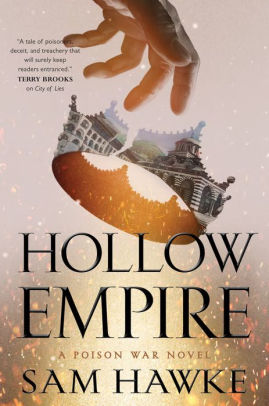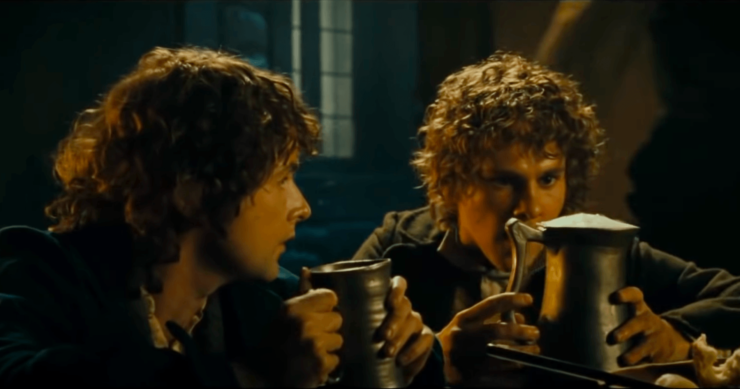Hobbits live the good life: they eat all day, they generally work with their hands and enjoy nature (unless they are wealthy and don’t work at all), and they live in an idyllic farmscape full of lush trees, rivers, and green hills. They also consume their fair share of ale in taverns, an ode to the pub culture that J.R.R. Tolkien himself heralded from.
But how much can a hobbit actually drink?
There is a joke in the Lord of the Rings films that is not present in the books—while hanging around at The Prancing Pony, Merry comes back to the table with a great big tankard. and Pippin asks what he’s drinking:
“This, my friend, is a pint,” he says wickedly.
Pippin’s eyes widen. “It comes in pints?”
It makes sense that hobbits would veer toward smaller pours because they are smaller people—you wouldn’t give a five-year-old a pint glass of juice because they have smaller stomachs and the glass would be harder to manage in smaller hands. But even if the average hobbit goes from half-pint to half-pint, that doesn’t mean that their rates of consumption are low in the alcohol department.
So how much can they put away when they’re tavern-crawling with pals? It depends on a multitude of interesting factors….
Hobbit measurements. According to Tolkien, hobbits are generally two-to-four feet tall, with the average height being three feet and six inches. This is during the events of LOTR; Tolkien claims that hobbits alive today rarely reach three feet. [The Fellowship of the Ring, “Concerning Hobbits”] Of course, a full-grown hobbit will average more body weight than your typical human child of the same height thanks to a slower metabolism and their famous love of food (“Elevensies” is a thing!), so we can estimate that while a 42-inch-tall child weighs 40.5 pounds on average, a hobbit will clock in at around 70 pounds. Being generally smaller also means having a smaller stomach, but that shouldn’t prove a problem; your average adult stomach can expand greatly to hold multiple liters if needed—that means a hobbit can probably stomach 1.5 liters (more than 3 pints) without much effort. So that means that volume isn’t too much of a concern while drinking.
Type of Beer. LOTR refers to hobbit brew as both “beer” and “ale.” As we observe various species getting drunk off of the ale presented, we can assume that Tolkien is not referring to the small beers of yesteryear, but the average fare one might find in a pub in the 20th century. The majority of hobbit ales can be labeled as session beers, lending themselves to long nights out after a hard day’s work.
Alcohol Content. Ale averages around 3-6% ABV. For the sake of easier math, let’s assume 5% ABV for your typical hobbit ale. Something that’s sessionable, but not so low that your average Man wouldn’t notice the kick, since the hobbits are clearly fine drinking beverages that are brewed with Big Folk in mind, too.
Buy the Book


Hollow Empire
Units of Alcohol. The specific unit for a measure of beer is also important here. It’s probable that a pint in Middle-earth is an Imperial pint, which is different from the American unit. (The Imperial pint is larger.) A full Imperial pint is 568 milliliters, making a half-pint 284 milliliters.
Alcohol Elimination Rate. This is one of the key variant factors in determining how quickly hobbits can process alcohol; contrary to what many people believe, your metabolism has very little to do with how quickly you process alcohol. The biological process that determines that is actually a construct called the Alcohol Elimination Rate, which is basically a calculation that determines how quickly your liver can filter the alcohol in your system.
One of the factors in this calculation is the frequency of how often you drink; a person who drinks regularly will eliminate alcohol faster than someone who only drinks once in a while because they’ve built a chemical “tolerance”. Another factor is the size of your liver compared to your body mass. If a hobbit’s liver size in relation to their body size is similar to that of an adult human, they will eliminate alcohol at relatively the same rate as an adult human. If a hobbit’s liver size is larger than an adult human one (which is true for children) when compared to their body size, than they are more likely to have an alcohol elimination rate closer to an alcoholic or a child. It is entirely possible—perhaps even probable—that hobbits have proportionally larger livers, the same way a human child would. Given that hobbits have a relatively constant rate of consumption (six meals a day, when they can get them), their systems are not exactly the same as one scaled for a human.
With that in mind, it’s time to do some math!
Blood alcohol content is generally determined by the Widmark formula. While this formula is not absolute, it gives us a helpful baseline. Here is an updated version of the formula:
% BAC = (A x 5.14 / W x r) – .015 x H
Here are the variables that you need to account for:
A = liquid ounces of alcohol consumed
W = a person’s weight in pounds
r = a gender constant of alcohol distribution (.73 for men and .66 for women—this one is tricky on flexibility)
H = hours elapsed since drinking commenced
The .015 in the equation is the average Alcohol Elimination Rate for a social drinker. If hobbits do indeed have a higher Elimination Rate, than that number should be altered to around .028 for the formula to give an accurate BAC%. We determine A by calculating amount of alcohol in the ale consumed, which is the number of liquid ounces in one beverage multiplied by the number of beverages consumed multiplied by the ABV of the beverage. If a hobbit consumes two half-pints of ale, the formula for A looks like this:
9.6 ounces x 2 half-pints x 5% ABV = .96 oz
If we use this formula to account for the BAC of a male hobbit who has had two half-pints of ale over the course of an hour on an empty stomach, with an average human Elimination Rate, this is what we get:
(.96 x 5.14 / 70 x .73) – .015 x 1
(4.934/ 51.1) – .015 x 1
.0965 – .015 x 1 = .082 BAC%
For the record, .08% puts you over the legal limit for driving in the U.S. (Granted, hobbits don’t drive cars. Do they need a license for ponies?) Let’s see what happens when we adjust for the Elimination Rate of someone with a larger liver, closer to the range of a chronic drinker:
.0965 – .028 x 1 = .069 BAC%
If we assume the latter, then a hobbit who puts away a pint in an hour would be in the “buzzed” territory—lowered inhibitions, a bit louder and more boisterous, emotions intensified. If the same hobbit consumed 1.5 pints in the same hour, their BAC would rocket up to .12%, leading to serious motor skill and memory impairment as well as poor self-control. Two whole pints in an hour would lead to a BAC of .17%, making this same hobbit start to feel dizzy or nauseous, with blurred vision and a possible risk of blackout. By three pints and a BAC of .26%, the poor guy is probably throwing up near some poor farmer’s stables and leaning on his pals for support because he cannot walk without assistance.
So, if a hobbit consumes a steady half-pint an hour, they’d maintain a vague euphoria. But if they plan on consuming at a more rapid rate, they have to watch themselves (or have some good pals looking out for them). Which means that hobbits process alcohol similarly to humans, just in smaller portion sizes. And they likely have awesome livers getting the work done for them.
Just some useful info for when the hobbits drop by your house looking to party…
Originally published in October 2016.
Emmet Asher-Perrin tried hobbit beer in New Zealand. It was delicious. You can bug them on Twitter and Tumblr, and read more of their work here and elsewhere.










